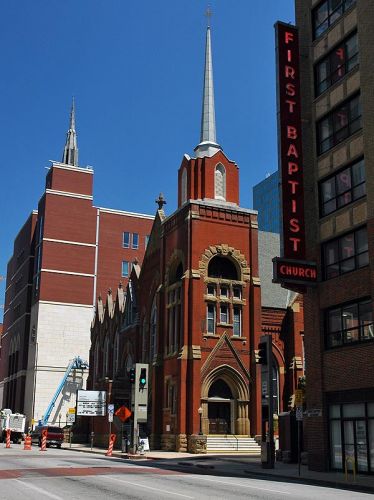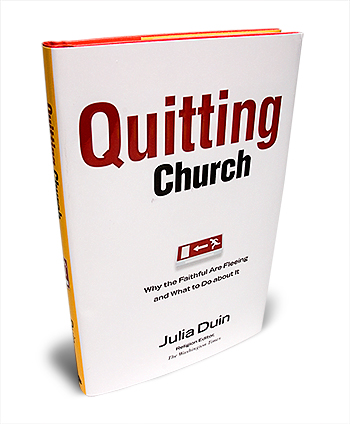Exiting the thriving evangelical pews?
 If you've been following our coverage of the debates about Gov. Sarah Palin and her faith, you know that many people do not know what label to stick on her. Is she a "fundamentalist"? Is she a "Pentecostal" Christian? A "charismatic"? An off-the-rack, nondenominational, evangelical Protestant? Let's face it, the post-denominational world is very complex and that reality is not going away anytime soon. Honest.
If you've been following our coverage of the debates about Gov. Sarah Palin and her faith, you know that many people do not know what label to stick on her. Is she a "fundamentalist"? Is she a "Pentecostal" Christian? A "charismatic"? An off-the-rack, nondenominational, evangelical Protestant? Let's face it, the post-denominational world is very complex and that reality is not going away anytime soon. Honest.
For example, I ran across the following passage in a Washington Times recent column by veteran Godbeat reporter Julia "Stairway to Heaven" Duin. She was describing some frank remarks by the Rev. Robert Jeffress of First Baptist Church in Dallas, aired out for all to hear during a forum at the Religion Newswriters Association meetings here in Washington, D.C. Some of the religion-beat pros were stunned when Jeffress made it perfectly clear that he thought it was crucial for America to be led by Christians -- period.
"I believe we should always support a Christian over a non-Christian," Mr. Jeffress said, according to the Religion News Service. (I was not taking notes.) ... What's important, he emphasized, is that Christians rule the nation instead of unbelievers.
Having lived four years in Texas, I know plenty of folks there who feel that way. Many of the evangelicals I cover would agree with him, too. But many of the journalists in the crowd acted as though Mr. Jeffress was from the Blue Lagoon. I could see some of the scribes practically hyperventilating as the pastor talked. I could hear muttered comments. "The nerve!" "How dare he?" "Where did they find this guy?"
Indeed, where did they find him? This leads me to the Duin passage that I think is relevant to the firestorm surrounding Palin.
You see, there are Americans out there whose beliefs are similar to those of Palin and, yes, even Jeffress. First Baptist Dallas is not a small church. Thus, Duin provides this punchy summary of the frightening facts:
There's a whole world out there into which many in the media rarely venture. At this same religion-writer event, I picked up "Outreach," a magazine on how to "grow" bigger churches. According to it, the three leading church-growth states are California, Texas and Georgia. Florida and Arizona aren't far behind.
They found the largest 100 churches in the country have a combined attendance of 1,128,451, or 11,000 people per church. One of the fastest-growing congregations (No. 4) was McLean Bible Church in the Virginia suburbs, which added 3,399 people last year. Another is in the Maryland suburbs: Reid Temple AME Church in Glenn Dale, at 7,500 souls. (Outreach claimed it was up by 50 percent over the previous year.)
The magazine said nondenominational Christian churches lead the pack, followed by independent Baptists, Southern Baptists and the Assemblies of God. I noticed every pastor they cite is male. Almost no church has a denominational tag -- such as Methodist, Lutheran or Presbyterian -- to its name. Very few of these churches belong to the mainline Protestants. Most have names like New Life Church, the Rock Church, Potter's House and Grace Community. ...
Fellow ink-stained wretches, there's a lot of folks in flyover land who feel the same way he does. In fact, they outnumber us.
 Now, before you think that Duin has signed a contract to do public relations for the nation's megachurches, let me shamelessly point you toward her new book, which is called "Quitting Church: Why the Faithful Are Fleeing and What to Do About It." Click here for a large chunk of it. Also, here's a Wall Street Journal review and here's my own Scripps Howard News Service column about Duin's own remarks at another RNA panel.
Now, before you think that Duin has signed a contract to do public relations for the nation's megachurches, let me shamelessly point you toward her new book, which is called "Quitting Church: Why the Faithful Are Fleeing and What to Do About It." Click here for a large chunk of it. Also, here's a Wall Street Journal review and here's my own Scripps Howard News Service column about Duin's own remarks at another RNA panel.
You see, there is a paradox out there in megachurch land. It seems that they are in the best of times and, perhaps, in the worst of times.
Membership statistics are high, but in many cases they are stalled on a plateau. It's a large plateau, but there is evidence that some of the natives are not happy. Some are slipping out the back door. In a column about this trend behind the large statistics, Duin adds:
... Not all is well in the evangelical house. There are a few canary-in-a-coal-mine figures, such as a continual annual decline in baptisms in the Southern Baptist Convention (SBC) -- the nation's largest Protestant group. The SBC numbers its membership at 16 million, but 6.1 million actually attend the major worship services each week, according to the SBC's 2007 annual report. Among its young people, baptisms fell 40 percent between 1980 and 2005.
Then there was a survey of 15,000 people taken a year ago by Willow Creek Community Church, a huge congregation outside of Chicago. The results were disturbing: the older the Christian, the more dissatisfied he or she was with the church. Researchers identified two segments of unhappy Christians -- the spiritually "stalled" and the "dissatisfied." The latter were mature Christians who felt church was keeping them from growing. Together, they made up 25 percent of those polled. That's a big market share of fed-up consumers.
This is one of those cases where reporters have to hold two big ideas in their heads at the same time. The megachurches remain large and powerful. They are not going away. Yet there may be new stories -- sobering stories, for evangelicals -- emerging in the shadows of those huge sanctuaries. I urge other journalists to check out Duin's book and then try to figure out how to handle the news implications of both of these trends.